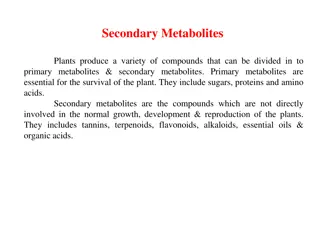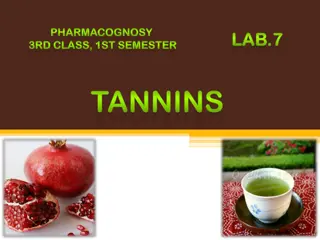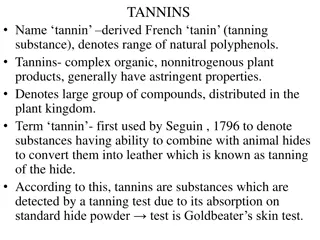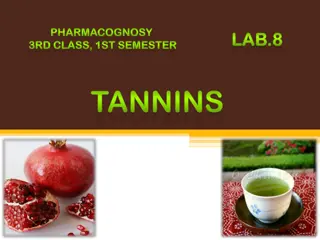Overview of Tannins: Composition, Chemistry, and Reactions
Tannins are complex organic substances found in various plant sources known for their astringent properties. They have therapeutic uses in medicines and commercial applications in industries like leather. Tannins form colloidal solutions, exhibit specific chemical reactions, and are classified into hydrolysable and condensed tannins based on their chemical nature. The classification is based on the behavior of tannins on dry distillation, with each group having distinct characteristics and uses.
Download Presentation

Please find below an Image/Link to download the presentation.
The content on the website is provided AS IS for your information and personal use only. It may not be sold, licensed, or shared on other websites without obtaining consent from the author. Download presentation by click this link. If you encounter any issues during the download, it is possible that the publisher has removed the file from their server.
E N D
Presentation Transcript
BP504 T. PHARMACOGNOSY AND PHYTOCHEMISTRY II (Theory) UNIT-II General introduction, composition, chemistry & chemical classes, biosources, therapeutic uses and commercial applications of following secondary metabolites: Tannins: Catechu (Pale and Black), Pterocarpus 1
Tannins Present in solution form in cell sap & in distinct vacuoles. Are known as astringent substances because they combine with tissue proteins & precipitate them, hence, they are used in medicines as mild antiseptics, in diarrhoea, & minor haemorrhages. Commercially, extensive application in leather industry, hides are treated with tannins to prevent the putrefaction. Are mixture of complex organic substances, & polyphenols are present with o-dihydroxy or o-trihydroxy groups on a phenyl ring. Have fairly high molecular weight & devoid of nitrogen. 2
Tannins Form colloidal solutions with water & are non-crystalline substances. In solution, show acidic reaction due to phenols. Also soluble in alcohol, glycerin, dil. alkalies, but insoluble in organic solvents except acetone. Chemical reactions of tannins A) Solution of tannin precipitates gelatin, & alkaloids. B) They are precipitated by salts of Cu, Sn, Pb, str. K2Cr2O7 sol. or chromic acid sol. C) Show color reactions with iron salts. FeCl3 gives bluish- black or brownish green color; K-ferricyanide with NH3 gives deep red color. 3
Chemical Reactions D) Goldbeater's skin test: Goldbeater's skin is a prototype of untanned fresh skin of an animal & obtained as membrane from intestine of ox. The membrane treated with HCl & rinsed with dis. H2O & then placed in tannin solution for 5 min. then washed with distilled water & keeping in FeSO4 solution. Color of skin gets brown or black color E) They are precipitated by a 2 % solution of phenazone, the tannin solution being prepared with sodium acid phosphate. 4
Classification of Tannins 2 groups based on complexity of chemical nature & as per their behaviour on dry distillation. A) Hydrolysable tannins: hydrolysed by acids/enzymes quickly & products of hydrolysis are Gallic acid or ellagic acid. On dry distillation, Gallic acid & other components are converted to pyrogallol. FeCl3sol. + Tannin sol. blue color. Ex. gallotannin in nutgall, rhubarb, clove & chestnut; ellagitannin from oak, myrobalans & pomegranate bark. 5
Classification B) Condensed tannins: known as non-hydrolysable tannins, phlobatannins or proanthocyanidins. Very resistant to hydrolysis. Related to flavonoids pigments as are formed via derivatives of flavones, like catechin or flavan-3-ol or flavan-3, 4-diols. On treatment with enzymes or mineral acids, they are polymerised or decomposed into red colored substances called phlobaphenes, insoluble in H2O & indicate the typical brownish-red color of many plants & drugs. On dry distillation- yield catechol FeCl3+ tannins brownish-green color Green tea, hamamelis leaves; cinchona, cinnamon & wild cherry bark; male fern rhizome; cocoa, cola & areca seeds; pale & black catechu are rich in condensed tannins. CH3OH, hot H2O, acetone, EtOAc - common solvents - extraction; extract is filtered & dried under vacuum. 6
Some structures OH COOH HO HO OH OH HO OH Catechol (Pyrocatechol) GLU O CO OH Glucogallin Gallic Acid O OC OH OH OH C O HO O OH OH OH Pyrogallol Ellagic acid 7
Classification Pseudotannins: are not as such a separate group of tannins, may be treated as subgroup. do not obey Goldbeater's skin test & are low molecular weight compounds. Ex: Chlorogenic acid in coffee & nux vomica, ipecacuanhic acid in ipecacuanha & catechins in cocoa. Detection of chlorogenic acid : Extract drug with H2O, treat extract with NH3 sol. Then expose to air, that leads formation of green color slowly HOOC OH OH O OH HO O OH Chlorogenic acid 8
Black Catechu Kattha, Cutch, Khadir-catechu, Catechu BS: dried aq. extract prepared from heartwood of Acacia catechu, Acacia chundra, Fam Leguminosae. Plants used for preparation of catechu are grown in India and Myanmar. History: To the time of chewing betel leaf, as an adjuvant. Olden days women used to color their feet. Since 15th century, exported to Europe. Old information is by a Portuguese writer Garcia de Orta in 1574. First Dr. Wrath used the scientific process to extract catechu, & showed that it consists of two parts: kattha and cutch. 9
Manufacture of Black Catechu Traditional method: separated heartwood boiled in earthen vessels fired by sap wood till the soluble portion extracted cooled naturally semisolid mass. On cooling less soluble fraction separates out & is removed as kattha & semi solid mass as cutch. Transferred to rectangular pits with sand & clay at bottom. Kept for several days till cutch part is absorbed by clay & solid mass, called kattha, taken out & moulded into blocks. Modern methods: Red heart wood obtained by felling separate bark & sapwood cut into chips mechanically put into extractors Pass steam for max. extraction concentrated under vacuum cooled by refrigeration Centrifuged to isolate cake of kattha moulded for sizes & dried 11
Black Catechu Good quality marketable kattha, ready for market is obtained. The mother liquor, left behind during centrifugation is concentrated, which on cooling gives cutch. Description: Color-Light brown- black Odor-None Taste - Very astringent, Size - About 2.5-5cm, Shape-Cube or irregular fragments of broken cubes or brick shaped pieces. Extra Feature: cubes & brick shaped pieces of catechu show presence of vegetable debris & break with a short fracture. The broken pieces are angular with pale cinnamon brown color. Catechu is friable & porous 12
Chemical Constituents Contains about 10% acacatechin, a distereoisomer of 5, 7, 3', 4' tetrahydroxy flavan-3-ols. Acacatechin also known as acacia catechin, undergoes oxidation to catechu tannic acid in presence of H2O & latter constitutes about 30% of drug. Other contents are catechu red, quercetin, gum & quercitrin Does not contain chlorophyll & fluorescent- substance present in pale catechu. OH OH HO O OH OH OH Catechol OH Catechin 13
Chemical Test A) black catechu + vanillin+ HCl pink/red color (Catechin) B) Catechin + HCl produces phloroglucinol, which burns along with lignin give purple/magenta color Tannin extract on match stick dipped in HCl, heated near the flame. C) Lime water + aq. Extract brown color turns to red precipitate on standing D) FeNH4SO4 + dil. Sol. of extract Green color + NaOH green colour turns to purple. 14
USES As an astringent externally for boils, skin eruptions and ulcers. Used in cough & diarrhoea. Has cooling & digestive properties. Cutch is not much used medicinally, but for other purposes like dyeing and coloring, water softening, reducing the viscosity of drill mud, removal of mercaptans from gasoline, protective agent for fishing nets & in mfg. of ion-exchange resins. 15
Pale Catechu Gambier, Gambir, Catechu BS: Dried aq. extract of the leaves & young shoots of Uncaria gambier, family Rubiaceae. G S: Indigenous to S-E Asian regions like Arachipelago in Malaysia; cultivated in Singapore and Indonesia Cultivation & Collection: fields up to 170 m height, & propagation by sowing seeds in damp soil. Nursery beds raised & after 9 months, seedlings transplanted in open fields. First harvesting- plant attains a height 2 m. yeilds drug 20 years. Leaves & young shoots collected, boiled in pot called Cauldron, made up of wood & iron bottom for 3 hours & decoction is conc. till becomes pasty mass yellowish-green color. Moulded in cubes & dried. 16
Pale Catechu Description: occurs as reddish-brown colored cubical mass, friable in nature. When broken, shows cinnamon brown color & porous nature. No odor, highly astringent taste, first appears bitter & then sweet. When placed in water, it shows minute acicular crystals Chemical Constituents: Contains condensed tannins in the form of catechins 7-33%, catechutannic acid 22- 50% & catechu red. Also contains quercetin & gambier fluorescin. 18
Chemical Tests A) Match stick test for catechin: Dip match stick in HCl & warm near flame, purple color B) Test for gambier-fluorescin: drug extracted in alcohol + NaOH + few drops light petroleum + shake mixture, keep aside. Green fluorescence in light petroleum layer (distinction from black catechu). C) Drug + warm with CHCl3 filter in porcelain dish & evaporate to dryness. Shows greenish yellow color due to presence of chlorophyll D) Extract + mixture of vanillin + HCl pink/red colour. 19
Uses As an astringent in treatment of diarrhoea & as local astringent in the form of lozenges Mainly used in dyeing & tanning industries, & also for protecting the fishing nets. 20
PTEROCARPUS Bijasal; Indian kino tree, Red sandal wood, Malabar kino are Rakta chandan. In hindi Vijaysar B S: dried juice of plant Pterocarpus marsupium family Leguminosae obtained by making vertical incisions to the stem bark collected & dried. G S: hilly regions of Gujarat, MP, UP, Bihar, Orissa. Forests Of Karnal, Kerala, W Bengal & Assam. Macroscopy: Color-ruby-red Odor-odorless Taste - astringent Size -3-10mm granules Shape-angular grains Pieces of kino- angular, glistening, transparent, breaking with vitreous fracture. Partly soluble in H2O (about 80-90%), completely soluble in alcohol (90%). 22
PTEROCARPUS: Chemical Constituents Contains about 70 -80% of kinotannic acid, kino-red, k- pyrocatechin (catechol), resin, Gallic acid. Kinotannic acid is glucosidal tannin, while kino-red is anhydride of kinoin. Kinoin is insoluble phlobaphene & produced by the action of oxidase enzyme. Darker in color than kinotannic acid. Crystalline principle santal, pterocarpin & homo- pterocarpin present in the wood. If the juice is boiled during drying, enzyme gets destroyed & thus, insolubilisation & darkening is prevented. 23
PTEROCARPUS: Chemical Constituents Contains about 70 -80% of kinotannic acid, kino-red, k- pyrocatechin (catechol), resin, Gallic acid. Kinotannic acid is glucosidal tannin, while kino-red is anhydride of kinoin. Kinoin is an insoluble phlobaphene & produced by the action of oxidase enzyme. Darker in color than kinotannic acid. Crystalline principle santal, pterocarpin & homo- pterocarpin present in the wood. If the juice is boiled during drying, enzyme gets destroyed & thus, insolubilisation & darkening is prevented. 24
PTEROCARPUS: Identification Test: 1. Drug sol. + FeSO4 green color 2. Drug sol. + alkali KOH violet color 3. Drug sol. + mineral acid precipitate Uses : As powerful astringent & in treatment of diarrhoea & dysentery, passive haemorrhage, toothache & diabetes, used in dyeing, tanning & printing. The aq. infusion of wood in diabetes. Both the alcoholic & aq. extracts of heartwood hypoglycemic For treatment of diabetes the cups made of wood are available with sales outlets of Khadi & Gramodyog Commission. 25























